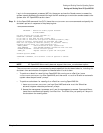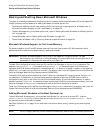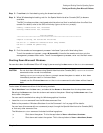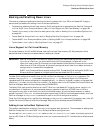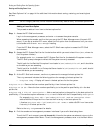
Chapter 4
Booting and Shutting Down the Operating System
Booting and Shutting Down Linux
163
Booting and Shutting Down Linux
This section presents procedures for booting and shutting down the Linux OS on cell-based HP Integrity
servers and a procedure for adding Linux to the boot options list.
• To determine whether the cell local memory (CLM) configuration is appropriate for Red Hat Enterprise
Linux or SuSE Linux Enterprise Server, refer to “Linux Support for Cell Local Memory” on page 163.
• To add a Linux entry to the nPartition boot options list, refer to “Adding Linux to the Boot Options List”
on page 163.
• To boot Red Hat Enterprise Linux, refer to “Booting Red Hat Enterprise Linux” on page 165.
• To boot SuSE Linux Enterprise Server, refer to “Booting SuSE Linux Enterprise Server” on page 166.
• To shut down Linux, refer to “Shutting Down Linux” on page 167.
Linux Support for Cell Local Memory
On servers based on the HP sx2000 chipset, each cell has a cell local memory (CLM) parameter, which
determines how firmware interleaves memory residing on the cell.
IMPORTANT Red Hat Enterprise Linux does not support using CLM. Before booting Red Hat Enterprise
Linux on an nPartition, you must ensure that the CLM parameter for each cell in the
nPartition is set to zero (0). Although you might be able to boot Red Hat Enterprise Linux on an
nPartition with CLM configured, any memory configured as cell local is unusable, and such a
configuration is untested and unsupported.
SuSE Linux Enterprise Server supports using CLM. The optimal CLM settings for SuSE Linux
Enterprise Server depend on the applications and workload the OS is running.
To check CLM configuration details from an OS, use Partition Manager or the parstatus command. For
example, the parstatus -V -c# command and parstatus -V -p# command report the CLM amount
requested and CLM amount allocated for the specified cell (-c#, where # is the cell number) or the specified
nPartition (-p#, where # is the nPartition number). For details, refer to the HP System Partitions Guide or the
Partition Manager Web site (http://docs.hp.com/en/PARMGR2/).
To display CLM configuration details from the EFI Shell on a cell-based HP Integrity server, use the info
mem command. If the amount of noninterleaved memory reported is less than 512 MB, then no CLM is
configured for any cells in the nPartition (and the indicated amount of noninterleaved memory is used by
system firmware). If the info mem command reports more than 512 MB of noninterleaved memory, then use
Partition Manager or the parstatus command to confirm the CLM configuration details.
To set the CLM configuration, use Partition Manager or the parmodify command. For details, refer to the HP
System Partitions Guide or the Partition Manager Web site (http://docs.hp.com/en/PARMGR2/).
Adding Linux to the Boot Options List
This section describes how to add a Linux entry to the system boot options list. The processes for adding both
Red Hat Enterprise Linux and SuSE Linux Enterprise Servers are given here.
You can add the \EFI\redhat\elilo.efi loader or the \efi\SuSE\elilo.efi loader to the boot options list
from the EFI Shell or EFI Boot Configuration menu (or in some versions of EFI, the Boot Option Maintenance
Menu).





